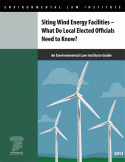
Research Reports
ELI publishes Research Reports available for free download that present the analysis and conclusions of the policy studies ELI undertakes to improve environmental law and policy. These reports contribute to education of the profession and disseminate diverse points of view and opinions to stimulate a robust and creative exchange of ideas. Those publications, which express opinions of the authors and not necessarily those of the Institute, its Board of Directors, or funding organizations, exemplify ELI’s commitment to dialogue with all sectors.
Across the country, states are experimenting with innovative new approaches to brownfields and petroleum brownfields remediation and redevelopment. Through simplified regulatory processes, new methods for supporting redevelopment, and greater information sharing, states are overcoming longstanding obstacles to remediation projects. This report provides concrete examples of applied practices and programs currently in use throughout the country, along with information about regulatory and procedural changes that states have successfully deployed.
Read More >
A review of the potential for seafood traceability systems to reduce illegal catch and mislabeling.
Read More >
Siting Wind Energy Facilities – What Do Local Elected Officials Need to Know? is a brief guide to aid local officials in understanding commercial-scale wind siting. Local government officials presented with potential wind energy projects in their municipalities often find that clear and concise answers to their citizens ’ concerns can be difficult to locate.
Read More >
